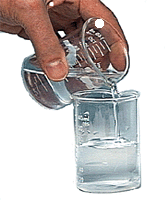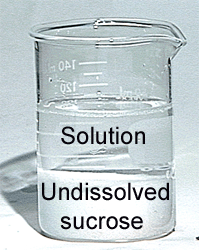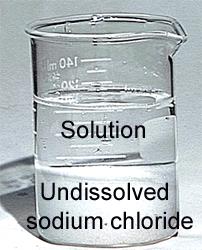



| FIGURE 11.1 Soluble and insoluble. Alcohol is soluble in water; when added to water, it forms a clear solution. Oil is insoluble in water; when added to water, the two liquids form separate layers. |
The solubility of a substance is the amount
of that substance that will dissolve in a given amount of solvent. Solubility
is a quantitative term. Solubilities very enormously (recall Table 8.2).
The terms soluble and insoluble are relative. A substance is said
to be soluble if more than 0.1 g of that substance dissolves in 100 mL solvent.
If less than 0.1 g dissolves in 100 mL solvent, the substance is said to be insoluble or, more exactly, sparingly soluble. The terms miscible
and immiscible may be encountered when considering the solubility of one liquid
in another. Miscible means soluble without
limits; for example, alcohol is miscible with water Immiscible and insoluble mean
the same; oil is immiscible with water, as in oil and vinegar salad dressing
(see Figure 11.1).




| FIGURE 11.1 Soluble and insoluble. Alcohol is soluble in water; when added to water, it forms a clear solution. Oil is insoluble in water; when added to water, the two liquids form separate layers. |
A. Determining Solubility
How is the solubility of a substance determined? A known amount of the solvent--for
example, 100 mL--is put in a container. Then the substance whose solubility
is to be determined is added until, even after vigorous and prolonged stirring,
some of that substance does not dissolve. Such a solution is said to be saturated
because it contains as much solute as possible at that temperature. In this
saturated solution, the amount of solute is the solubility of that substance
at that temperature in that solvent. Doing this experiment with water as the
solvent and sodium chloride as the solute, we find that, at 20°C, 35.7 g
of the salt dissolve in 100 mL water. The solubility of sodium chloride is,
then, 35.7 g/100 mL water at 20°C. Sodium chloride is a moderately soluble
salt. The solubility of sodium nitrate is 92.1 g/100 mL water at 20°C; sodium
nitrate is a very soluble salt. At the opposite end of the scale is barium sulfate,
which has a solubility of 2.3 X 10 -4 g/100 mL water at 20°C.
Barium sulfate is an insoluble salt. See Table
8.2 for the solubility of other compounds and Table
8.3 for the rules predicting the solubility of ionic compounds.
B. Saturated Solutions
A saturated solution is one in which the dissolved solute is in equilibrium with the undissolved solute. The container in figure 11.2a holds a saturated solution of sucrose (cane sugar); at the bottom of the container is some undissolved sucrose. If we could see the individual molecules in this solution, we would see that some of the molecules of sucrose are moving away from the solid crystals at the bottom of the container as they dissolve. The same number of molecules are coming out of solution to become part of the undissolved sucrose.


| FIGURE 11.2 Equilibrium in solutions: the equilibrium in a sucrose solution between dissolved and undissolved molecules; the equilibrium in an ionic solution between dissolved ions and undissolved sodium chloride. |
Dissolution (dissolving) and precipitation are occurring at the same rate, thereby satisfying the requirement for a dynamic equilibrium. This requirement was set forth in Section 10.3, where we discussed the equilibrium between liquid and vapor. We can express the equilibrium in the sucrose solution with the equation
sucrose(s)
sucrose(aq)
Two statements can be made about this solution: (1) the two processes dissolution and precipitation are going on at the same time, and (2) the number of molecules in the solution remains constant.
A saturated solution of an ionic compound is slightly different from that of a covalent compound like sucrose. The ionic compound dissolves and exists in solutions as ions; the covalent compound dissolves and exists in solutions as molecules. The equilibrium of sodium chloride with its ions in a saturated solution would be shown by the equation
NaCl(s)
Na+(aq) + Cl-(aq)
These equilibria are diagramed in Figure 11.2. An unsaturated solution contains less solute than does a saturated solution. No equilibrium is present. When additional solute is added to an unsaturated solution, it dissolves. When additional solute is added to a saturated solution, the amount of dissolved solute does not increase, because the limit of solubility has already been reached. Adding more solute to a saturated solution simply increases the amount of undissolved solute.
Remember in discussing these solutions that solubility changes with temperature. (This factor will be discussed further in Section 11.2C2.) A solution that is saturated at one temperature may be unsaturated at a different temperature.
This spot is perhaps appropriate for a few comments on preparing solutions. Dissolution requires interaction between the molecules (or ions) of the solute and the molecules of the solvent. A finely divided solute will dissolve more rapidly than one that is in large chunks, because more contact is made between solute and solvent. Constant stirring increases the rate of dissolution, because stirring changes the particular solvent molecules that are in contact with undissolved solute. Because the solubility of solids and liquids generally increases with temperature, solids and liquids are often dissolved in warm solvents.
C. Factors Affecting Solubility
Many factors affect the solubility of one substance in another. We will discuss a few, in particular.
1. Forces between particles
One factor that affects solubility is the nature of the intermolecular forces
or interionic forces in both the solute and the solvent. In Chapter 10, we listed
the kinds of forces operating in solids and liquids. When one substance dissolves
in another, the attractive forces in both must be overcome. The dissolving solute
must be able to break up the aggregation of molecules in the solvent (that is,
the hydrogen bonds between molecules or the dispersion forces between molecules
in a nonpolar solvent), and the molecules of the solvent must have sufficient
attraction for the solute particles to remove them one by one from their neighbors
in the undissolved solute. If the solute is ionic, only a very polar solvent
like water provides enough interaction to effect dissolution (see Figure
7.17). In those ionic compounds like barium sulfate that are called insoluble,
the interaction between the ions is greater than can be overcome by interaction
with the polar water molecules. If the solute particles are polar molecules,
polar solvents such as alcohols can usually effect dissolution. If the solute
is nonpolar, it may dissolve only in nonpolar solvents, not because polar solvent
molecules are unable to overcome the weak dispersion forces between the solute
molecules, but because these dispersion forces are too weak to overcome the
dipole-dipole interaction between the solvent molecules.
A general rule is that like dissolves like. Ionic and polar compounds are most apt to be soluble in polar solvents like water or liquid ammonia. Nonpolar compounds are most apt to be soluble in nonpolar solvents, such as carbon tetrachloride, and hydrocarbon solvents like gasoline.
The solubility of gases in water depends a great deal on the polarity of the gas molecules. Those gases whose molecules are polar are much more soluble in water than are nonpolar gases. Ammonia, a strongly polar molecule, is very soluble in water (89.9 g/100 g H2O); so is hydrogen chloride (82.3 g/100 g H2O). Helium and nitrogen are nonpolar molecules. Helium is only slightly soluble (1.8 X 10-4 g/100 g H2O), as is nitrogen (2.9 X 10-3 g/100 g H2O).
Table 11.1 shows specific examples of different kinds of compounds and their relative solubilities in water, a polar solvent; in alcohol, a less polar solvent; and in benzene, a nonpolar solvent.
| Solubility in | ||||
|---|---|---|---|---|
| Kinds of bonds | Example | Water | Alcohol | Benzene |
| ionic | sodium chloride | very soluble | slightly soluble | insoluble |
| polar covalent | sucrose (sugar) | very soluble | soluble | insoluble |
| nonpolar covalent | napthalene | insoluble | soluble | very soluble |
2. Temperature
Table 11.2 shows the solubility of several substances in water at 20°C and 100°C. Notice that the solubilities of solids and liquids usually increase as the temperature increases, but the solubilities of gases decrease with increasing temperature. This property of gases causes our concern for the fish population of lakes, oceans, and rivers threatened with thermal (heat) pollution. Fish require dissolved oxygen to survive. If the temperature of the water increases, the concentration of dissolved oxygen decreases, and the survival of the fish becomes questionable.
| Solubility (g/100mL water) | |||
|---|---|---|---|
| Compound | Type of bonding | At 20°C | At 100°C |
| sodium chloride | ionic | 35.7 | 39.1 |
| barium sulfate | ionic | 2.3 X 10-4 | 4.1 X 10-4 |
| sucrose | polar covalent | 179 | 487 |
| ammonia | polar covalent | 89.9 | 7.4 |
| hydrogen chloride | polar covalent | 82.3 | 56.1 |
| oxygen | nonpolar covalent | 4.5 X 10-3 | 3.3 X 10-3 |
3. Pressure
The pressure on the surface of a solution has very little effect on the solubilities
of solids and liquids. It does have an enormous effect on the solubility of
gases. As the partial pressure Section
9.6) of a gas in the atmosphere above the surface of a solution increases,
the solubility of that gas increases. A carbonated beverage is bottled and capped
under a high partial pressure of carbon dioxide so that a great deal of carbon
dioxide dissolves. When the bottle is uncapped, the partial pressure of carbon
dioxide above the liquid drops to that in the atmosphere, the solubility of
carbon dioxide decreases, and the gaseous CO2 comes out of solution
as fine bubbles.
This same phenomenon is of concern in scuba diving. As divers descend, they are under ever-increasing pressure due to the increasing mass of water above them. Each 33 ft of water exert a pressure of 1 atm. As the diver descends, the pressure on the air in the lungs increases rapidly, and the blood dissolves more than normal amounts of both nitrogen and oxygen. As the diver comes up, the pressure decreases and the gases come out of solution. If the change in pressure is too swift, the bubbles of gas are released into the blood stream and tissues, instead of into the lungs. The bubbles cause sharp pain wherever they occur, most notably in the joints and ligaments. This dangerous and sometimes fatal condition is called bends, the name deriving from the temporary deformities caused by the affected diver's being unable to straighten his or her joints. Because helium, at all pressures, is less soluble than nitrogen, divers often breathe a mixture of helium and oxygen instead of air, a nitrogen-oxygen mixture.
The term hyperbaric means greater-than-normal atmospheric pressure. In hyperbaric medical treatments, patients are subjected to a pressure greater than atmospheric. This pressure increases the amount of oxygen dissolved in the blood. Treatment in hyperbaric, or high-pressure, chambers is of particular value for patients who are suffering from severe anemia, hemoglobin abnormalities, or carbon monoxide exposure or undergoing skin grafts, for such treatment increases the amount of oxygen transported by the blood to the tissues.